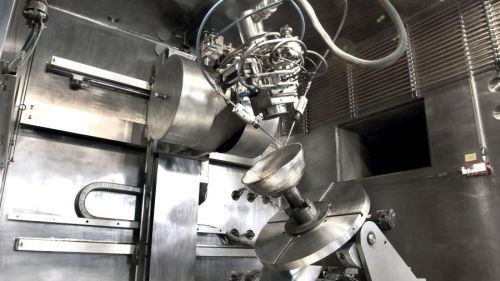Freedom in Electron Beam Additive Manufacturing
The wire-fed EBAM process offers flexibility in part geometry and size—as well as material properties.
Share









Hwacheon Machinery America, Inc.
Featured Content
View More
Autodesk, Inc.
Featured Content
View More
.png;maxWidth=45)
DMG MORI - Cincinnati
Featured Content
View More
Sciaky’s EBAM system is equipped with two wire feeders that travel with the electron beam head, enabling the building of large parts.
Electron Beam Additive Manufacturing (EBAM) holds plenty of possibilities for metal AM applications. The process builds parts using an electron beam to melt metal wire that travels with the beam head. In contrast to powder bed systems in which the size of the part is limited by the size of the bed, parts built on an EBAM system can be as large as the machine’s travels permit.
This capacity for building large parts plus its speed gives EBAM clear potential as an alternative to forging. Like forging, it is a near-net-shape process capable of building large forms. But unlike forging, it requires no die or other tooling, making it faster and more flexible. EBAM can provide design freedoms in geometry that forging cannot.
But perhaps more significantly, EBAM also provides material freedom. Chicago-based Sciaky has developed an EBAM system that allows for two different wires to be fed into the machine. This dual-fed system could be used to deposit two spools of wire simultaneously, increasing throughput, or loaded with both large-diameter and fine wire to provide a range of detail. However, its greatest potential may lie in the ability to blend wires of two different alloys within the same build, creating a proprietary alloy or even a gradient between materials.
Read more about the possibilities of EBAM and how Lockheed Martin is building propellant tank components with this technology on Additive Manufacturing magazine’s website.
Related Content
-
Push-Button DED System Aims for Machine Shop Workflow in Metal Additive Manufacturing
Meltio M600 metal 3D printer employs probing, quick-change workholding and wire material stock to permit production in coordination with CNC machines.
-
Designing a 3D Printed Part with Machining in Mind
Designing extra stock and mounting features into a 3D printed part can aid in machining processes downstream.
-
Go Digital: How to Succeed in the Fourth Industrial Revolution With Additive Manufacturing
The digitalization of manufacturing is set to transform production and global supply chains as we know them, and additive manufacturing has been leading the way in many industries.

.jpg;width=70;height=70;mode=crop)






























